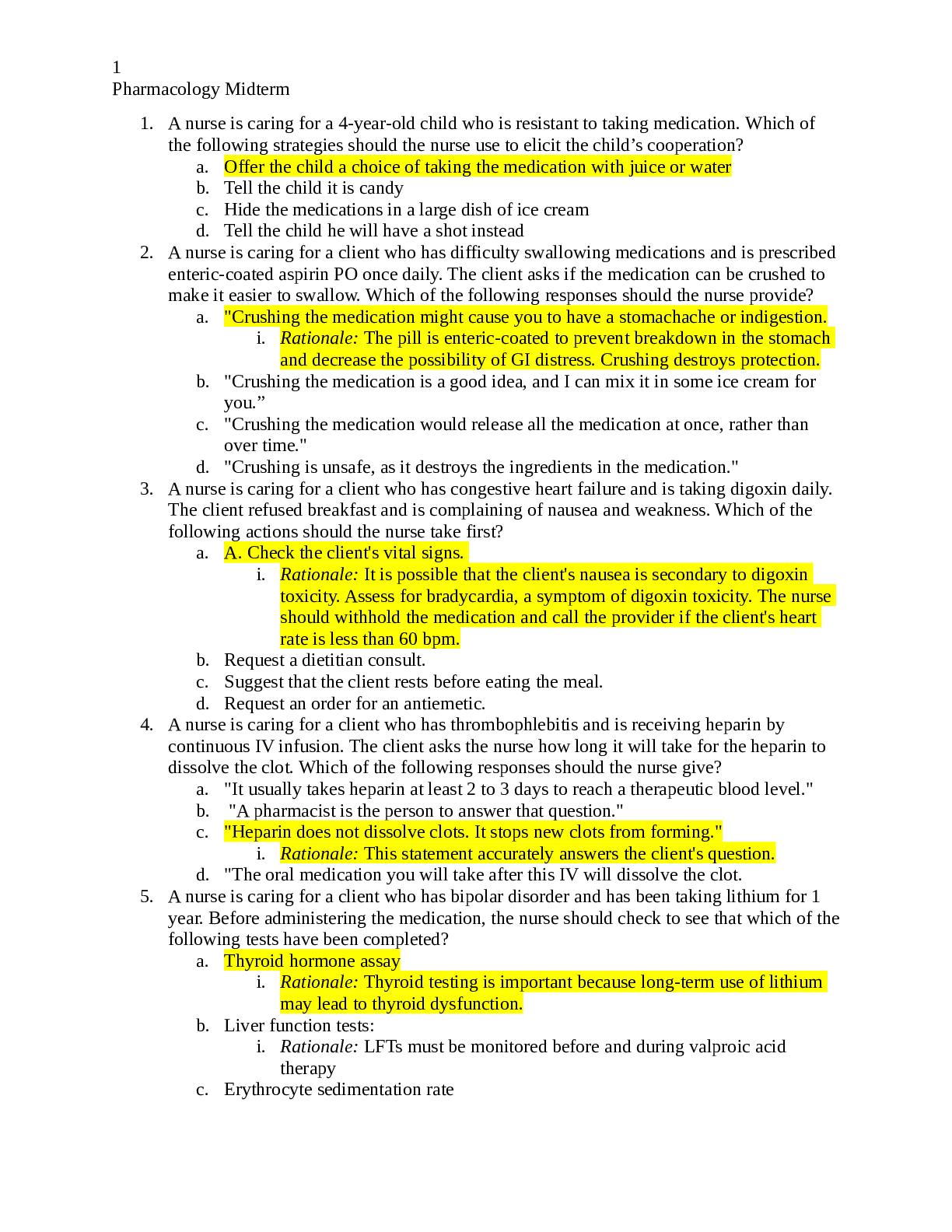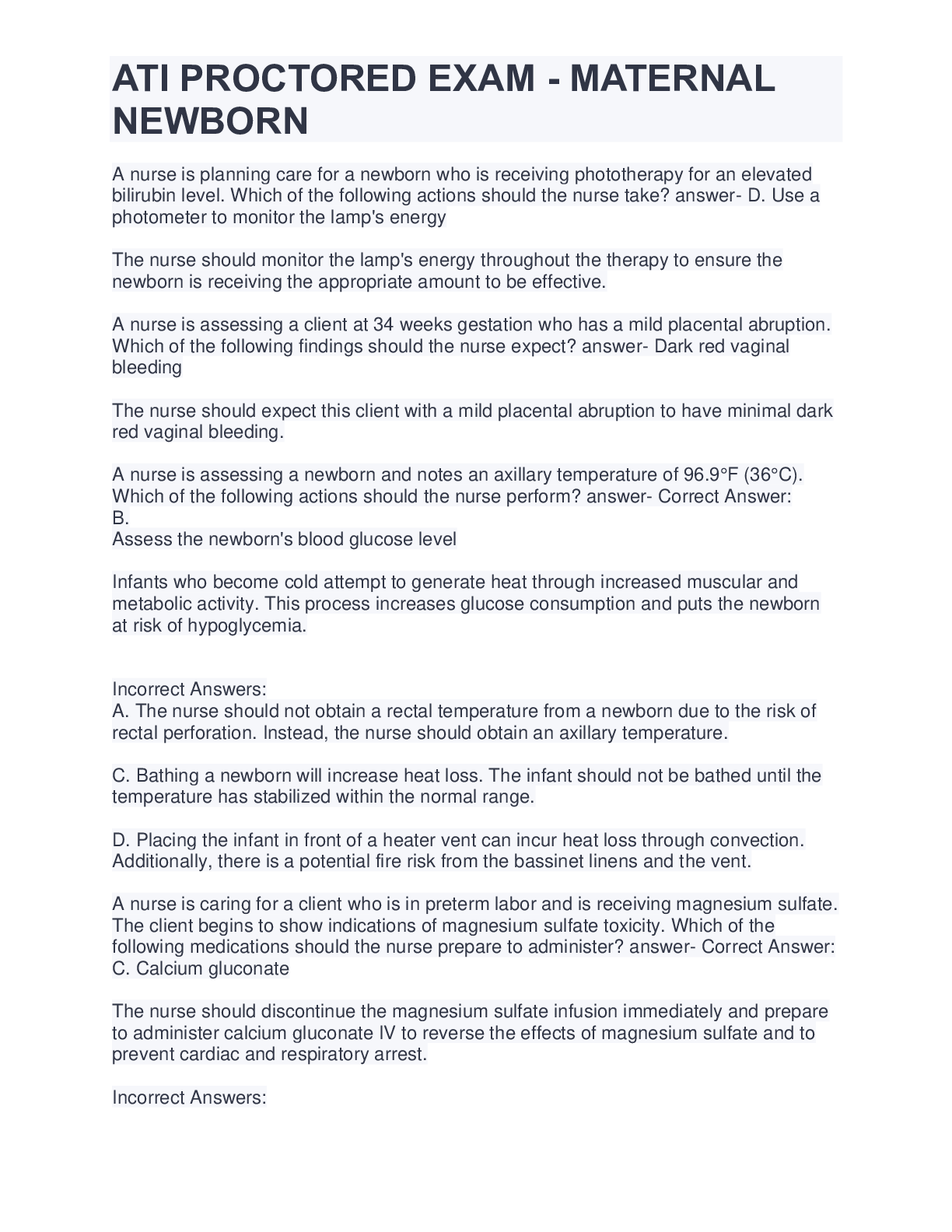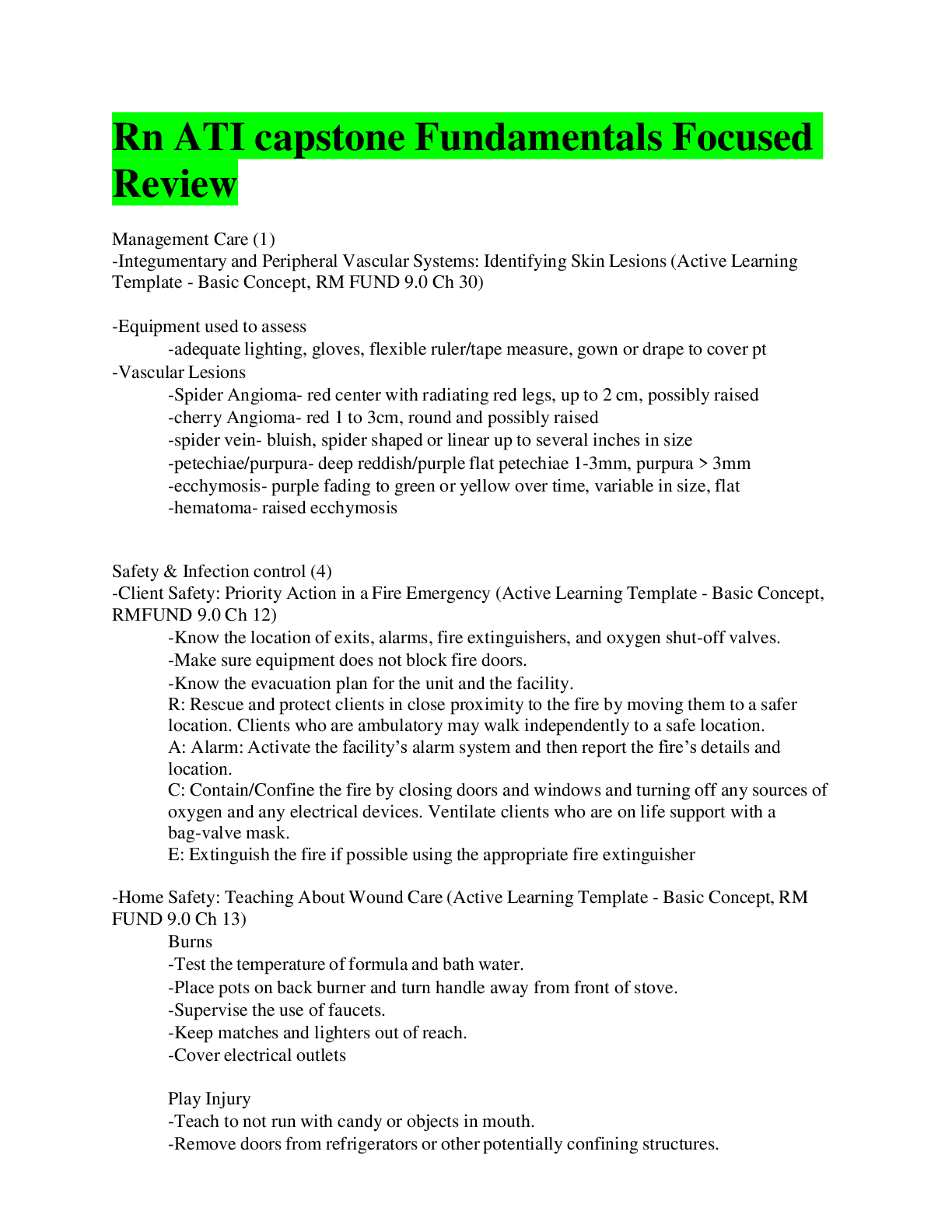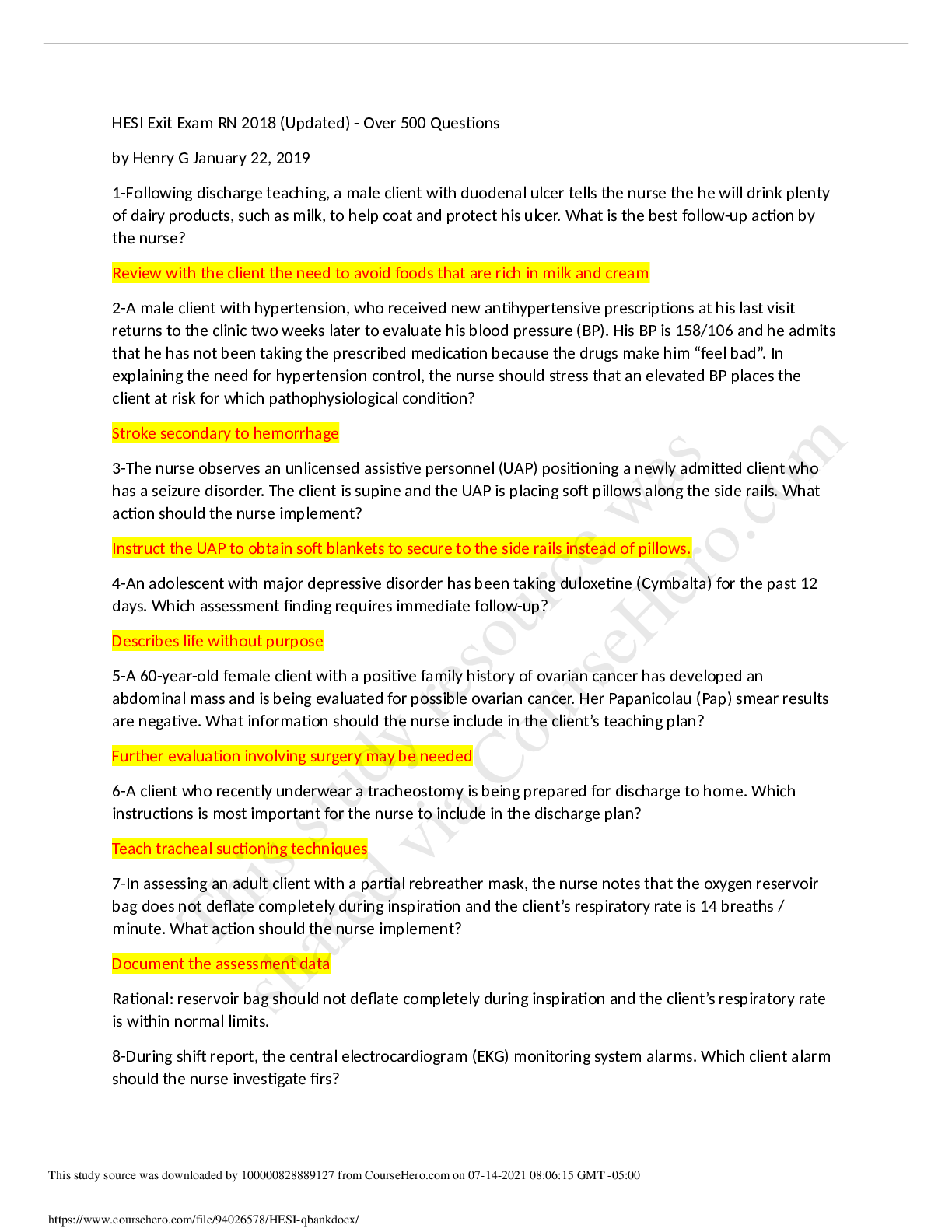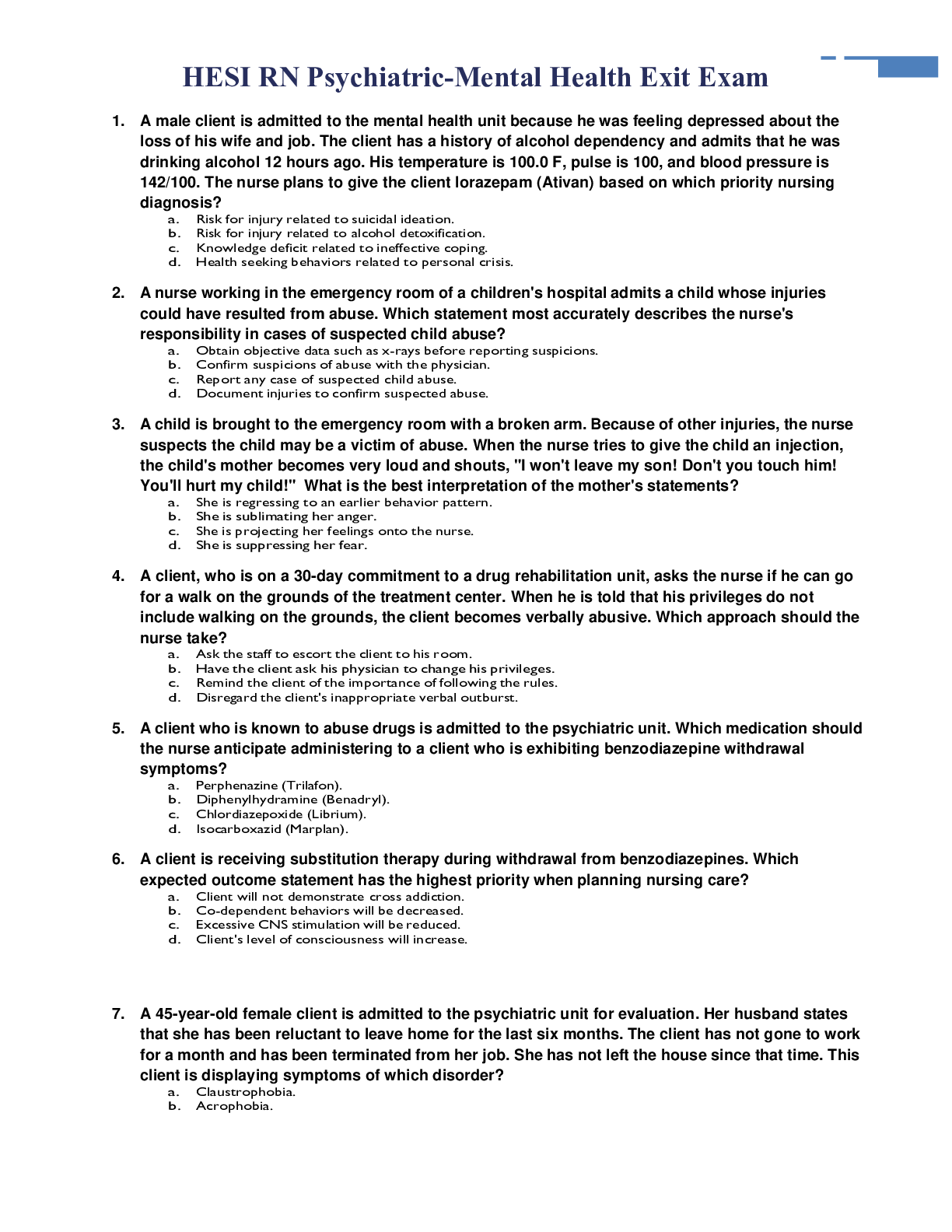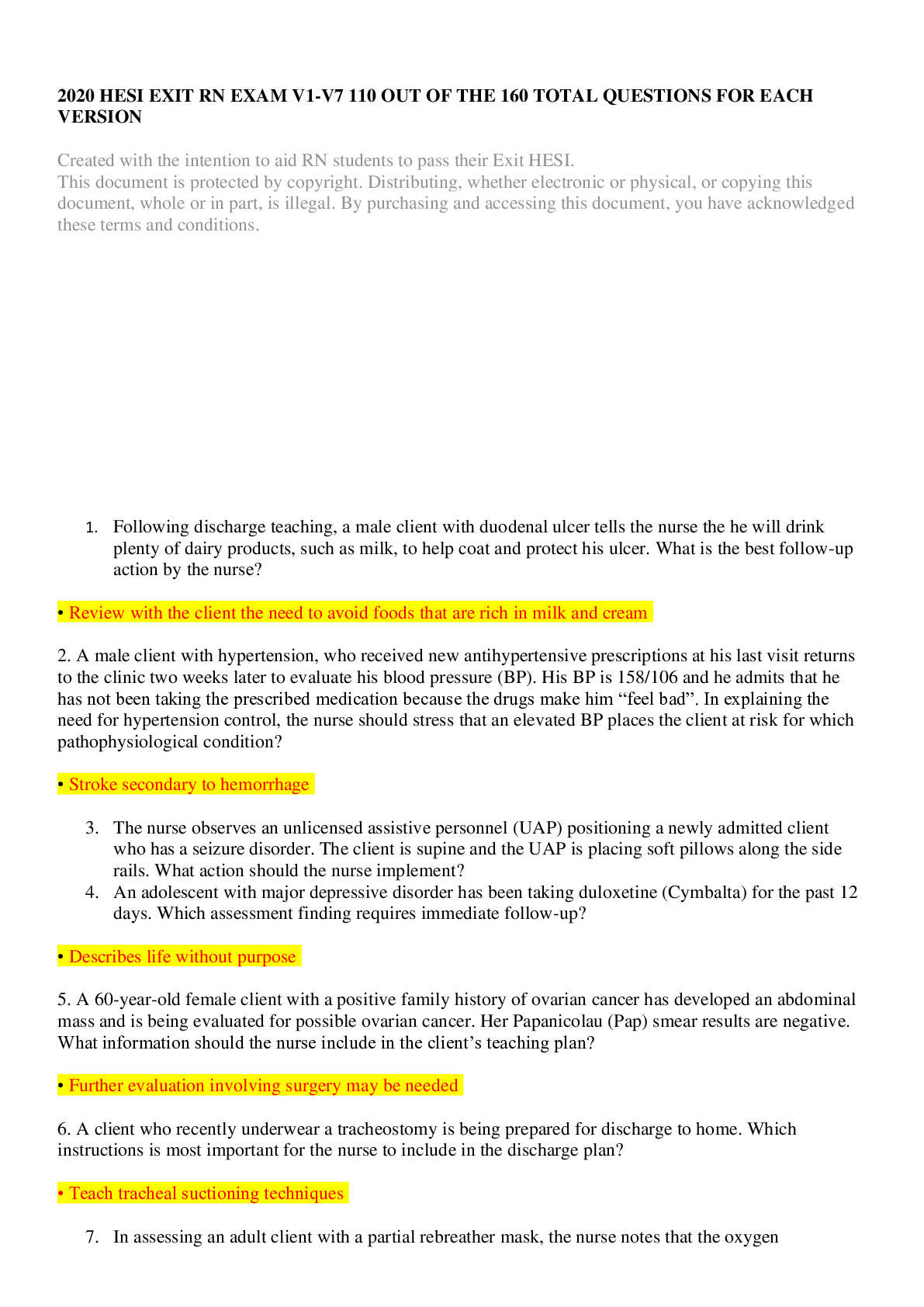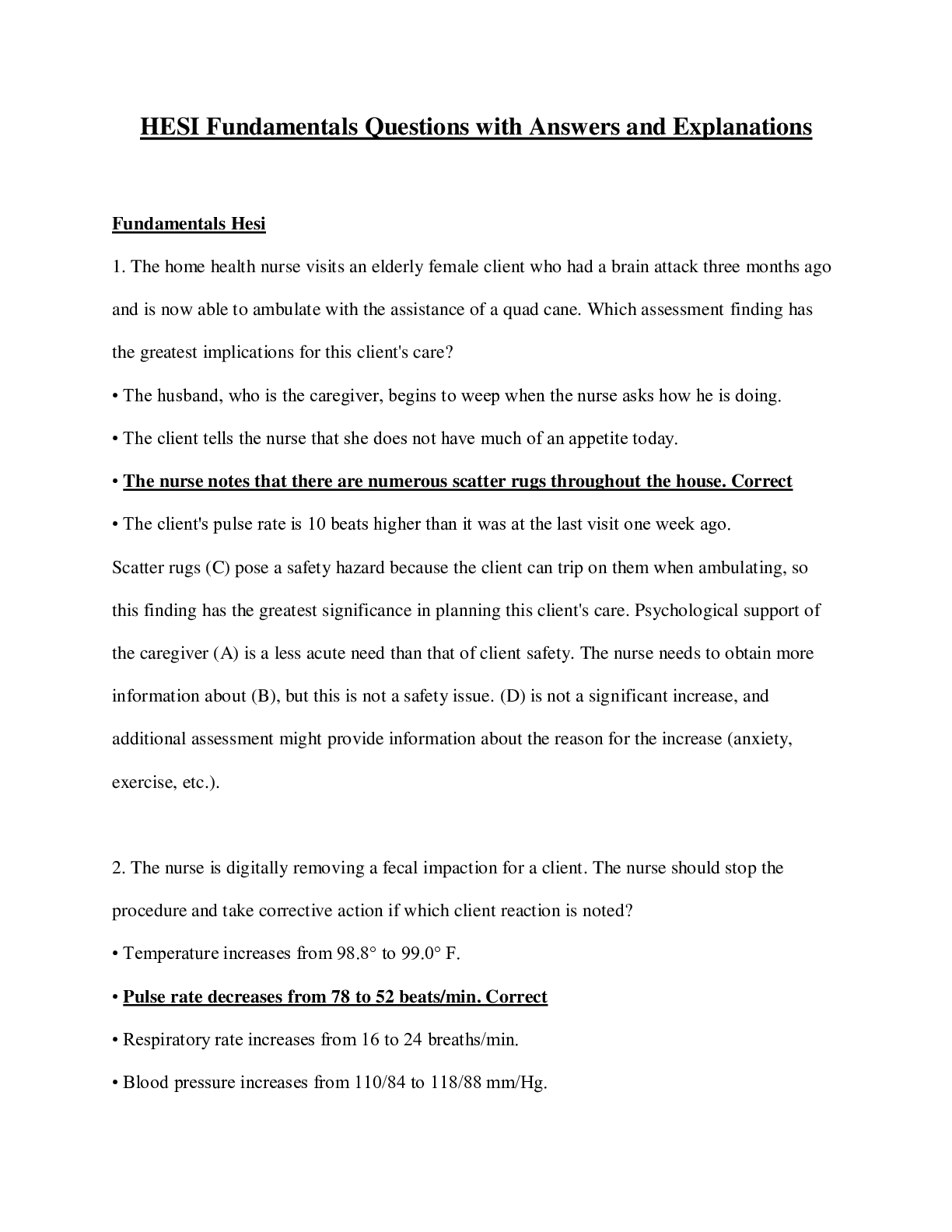NR326 MENTAL HESI 5_Graded A
Document Content and Description Below
NR 326 MENTAL HESI 5 - 2020 1. A male client is admitted to the mental health unit because he was feeling depressed about the loss of his wife and job. The client has a history of alcohol dependency a... nd admits that he was drinking alcohol 12 hours ago. His temperature is 100.0 F, pulse is 100, and blood pressure is 142/100. The nurse plans to give the client lorazepam (Ativan) based on which priority nursing diagnosis? a. Risk for injury related to suicidal ideation. b. Risk for injury related to alcohol detoxification. c. Knowledge deficit related to ineffective coping. d. Health seeking behaviors related to personal crisis. The most important nursing diagnosis is related to alcohol detoxification (B) because the client has elevated vital signs, a sign of alcohol detoxification. Maintaining client safety related to suicidal ideation (A) should be addressed after giving the client Ativan for elevated vital signs secondary to alcohol withdrawal. The client's knowledge deficit and health seeking behaviors (C and D) can be addressed when immediate needs for safety are met. 2. A nurse working in the emergency room of a children's hospital admits a child whose injuries could have resulted from abuse. Which statement most accurately describes the nurse's responsibility in cases of suspected child abuse? a. Obtain objective data such as x-rays before reporting suspicions. b. Confirm suspicions of abuse with the physician. c. Report any case of suspected child abuse. d. Document injuries to confirm suspected abuse. It is the nurse's legal responsibility to report all suspected cases of child abuse (C), and notifying the nurse manager or charge nurse starts the legal reporting process. (A, B, and D) delay the first step in reporting the abuse.3. A child is brought to the emergency room with a broken arm. Because of other injuries, the nurse suspects the child may be a victim of abuse. When the nurse tries to give the child an injection, the child's mother becomes very loud and shouts, "I won't leave my son! Don't you touch him! You'll hurt my child!" What is the best interpretation of the mother's statements? a. She is regressing to an earlier behavior pattern. b. She is sublimating her anger. c. She is projecting her feelings onto the nurse. d. She is suppressing her fear. Projection is attributing one's own thoughts, impulses, or behaviors onto another--it is the mother who is probably harming the child and she is attributing her actions to the nurse (C). The mother may be immature, but regression (A) is not the best description of her behavior. Sublimation (B) is substituting a socially acceptable feeling for an unacceptable one. These are not socially acceptable feelings. The mother may be suppressing her fear (D) by displaying anger, but such an interpretation cannot be concluded from the data presented. 4. A client, who is on a 30-day commitment to a drug rehabilitation unit, asks the nurse if he can go for a walk on the grounds of the treatment center. When he is told that his privileges do not include walking on the grounds, the client becomes verbally abusive. Which approach should the nurse take? a. Ask the staff to escort the client to his room. b. Have the client ask his physician to change his privileges. c. Remind the client of the importance of following the rules. d. Disregard the client's inappropriate verbal outburst. The client is trying to engage the nurse in a dispute. Ignoring the behavior (D) provides no reinforcement for the inappropriate behavior. (A) is not necessary unless the client becomes a physical threat to the nurse. It is inappropriate to delegate the situation to the physician (B) and is not in keeping with good health team management. Consistent limits must be established and enforced. (C)would subject the nurse to more verbal abuse. The client could use any response as an excuse to attack the nurse once again. 5. A client who is known to abuse drugs is admitted to the psychiatric unit. Which medication should the nurse anticipate administering to a client who is exhibiting benzodiazepine withdrawal symptoms? a. Perphenazine (Trilafon). b. Diphenylhydramine (Benadryl). c. Chlordiazepoxide (Librium). d. Isocarboxazid (Marplan). Librium (C), an antianxiety drug, as well as other benzodiazepines, are used for benzodiazepine withdrawal. (A) is an antipsychotic agent. (B) is an antihistamine and antianxiety drug. (D) is an MAO inhibitor. 6. A client is receiving substitution therapy during withdrawal from benzodiazepines. Which expected outcome statement has the highest priority when planning nursing care? a. Client will not demonstrate cross addiction. b. Co-dependent behaviors will be decreased. c. Excessive CNS stimulation will be reduced. d. Client's level of consciousness will increase. Substitution therapy with another CNS depressant is intended to decrease the excessive CNS stimulation that can occur during benzodiazepine withdrawal (C). (A, B, and D) are all appropriate outcome statements for the client described, but do not have the priority of (C). 7. A 45-year-old female client is admitted to the psychiatric unit for evaluation. Her husband states that she has been reluctant to leave home for the last six months. The client has not gone to work for a month and has been terminated from her job. She has not left the house since that time. This client is displaying symptoms of which disorder?a. Claustrophobia. b. Acrophobia. c. Agoraphobia. d. Necrophobia. Agoraphobia (C) is the fear of crowds or being in an open place. Claustrophobia (A) is the fear of being in closed places. Acrophobia (B) is the fear of high places. Necrophobia is an abnormal fear of death or bodies after death (D). A phobia is an unrealistic fear associated with severe anxiety. 8. A 19-year-old female client with a diagnosis of anorexia nervosa wants to help serve dinner trays to other clients on a psychiatric unit. What action should the nurse take? a. Encourage the client's self motivation by asking her to pass trays for the rest of the week. b. Provide an additional challenge by asking the client to help feed the older clients. c. Suggest another way for this client to participate in the unit's activities. d. Tell the client that hospital guidelines allow only staff to pass the trays. Clients with anorexia gain pleasure from providing others with food and watching them eat. Such behaviors reinforce their perception of self-control. These clients should not be allowed to plan or prepare food for unit activities and their desires to do so should be redirected (C). (A and B) are contraindicated for a client with anorexia nervosa. (D) avoids addressing the problem, so it is best to suggest another activity for the client. 9. A female client with depression attends a group and states that she sometimes misses her medication appointments because she feels very anxious about riding the bus. Which statement is the nurse's best response? a. "Can your case manager take you to your appointments?" b. "Take your medication for anxiety before you ride the bus."c. "Let's talk about what happens when you feel very anxious." d. "What are some ways that you can cope with your anxiety?" The best response is to explore ways for the client to cope with anxiety (D). The nurse should encourage problem-solving rather than dependence on the case manager (A) for transportation. Strategies for coping with anxiety should be encouraged before suggesting medication (B). Talking about anxious feelings (C) is therapeutic, but the best response is an open-ended question to explore ways to cope with the anxiety. 10. A woman brings her 48-yearold husband to the outpatient psychiatric unit and describes his behavior to the admitting nurse. She states that he has been sleepwalking, cannot remember who he is, and exhibits multiple personalities. The nurse knows that these behaviors are often associated with which condition? a. Dissociative disorder. b. Obsessive-compulsive disorder. c. Panic disorder. d. Post-traumatic stress syndrome. Sleepwalking, amnesia, and multiple personalities are examples of detaching emotional conflict from one's consciousness (A). (B) is characterized by persistent, recurrent intrusive thoughts or urges (obsessions) that are unwilled and cannot be ignored, and provoke impulsive acts (compulsions) such as handwashing. Panic (C) is an acute attack of anxiety characterized by personality disorganization. (D) is re-experiencing a psychologically terrifying or distressing event that is outside the usual range of human experience, such as war, rape, etc. 11. At the first meeting of a group of older adults at a day care center for the elderly, the nurse asks one of the members what kinds of things she would like to do with the group. The older woman shrugs her shoulders and says, "You tell me, you're the leader." What would be the best response for the nurse to make?a. "Yes, I am the leader today. Would you like to be the leader tomorrow?" b. "Yes, I will be leading this group. What would you like to accomplish?" c. "Yes, I have been assigned to lead this group. I will be here for the next six weeks." d. "Yes, I am the leader. You seem angry about not being the leader yourself." Anxiety over participation in a group and testing of the leader characteristically occur in the initial phase of group dynamics. (B) provides information and refocuses the group to defining its function. (A) is manipulative bargaining. (C) does not focus the group on its purpose or task. (D) is interpreting the client's feelings and is almost challenging. 12.Over a period of several weeks, one male client participant of a socialization group at a community day care center for the elderly monopolizes most of the group's time and interrupts others when they are talking. What is the best action for the nurse to take in this situation? a. Talk to the client outside the group about his behavior. b. Ask the client to give others a chance to talk. c. Allow the group to handle the problem. d. Ask the client to join another group. After several weeks, the group is in the working phase and the group members should be allowed to determine the direction of the group. The nurse should ignore the client's comments and allow the group to handle the situation (C). A good leader should not have separate meetings with group members (A), as such behavior is manipulative on the part of the leader. (B) is dictatorial and is not in keeping with good leadership skills. (D) is avoiding the problem. Remember, identify what phase the group is in--initial, working, or termination--as an aid to determining expected communication style.13.A client in the critical care unit who has been oriented suddenly becomes disoriented and fearful. Assessment of vital signs and other physical parameters reveal no significant changes, and the nurse formulates the diagnosis: "Confusion related to ICU psychosis." Which intervention is best to implement based on this client's behavior? a. Move all machines away from the client's bedside at once. b. Allay fears by teaching the client about disease etiology. c. Cluster care to allow for brief rest periods during the day. d. Encourage visitation by the client's family members. The critical care unit contains many life-saving treatment modalities that offer clients an array of auditory, visual, and even painful stimuli. These stressers can result in isolation and confusion. The best intervention is to provide the client with rest periods (C). Removing machinery (A) is not practical because the client may not survive without it. The client is too ill to receive an in-depth overview of his disease process (B). Although family members' presence (D) may be supportive, young children are routinely prohibited from critical care units due to increased risk of infectious disease transmission. 14.A client on the psychiatric unit appears to imitate a certain nurse on the unit. The client seeks out this particular nurse and imitates her mannerisms. Which defense mechanism does the nurse recognize in this client? a. Sublimation. b. Identification. c. Introjection. d. Repression. Identification (B) is an attempt to be like someone or emulate the personality traits of another. Sublimation (A) is substituting an unacceptable feeling for one that is more socially acceptable. Introjection (C) is incorporating the values or qualities of an admired person or group into one's own ego structure. Repression(D) is the involuntary exclusion of painful thoughts or memories from one's awareness. 15.A nurse working on a mental health unit receives a community call from a person who is tearful and states, "I just feel so nervous all of the time. I don't know what to do about my problems. I haven't been able to sleep at night and have hardly eaten for the past 3 to 4 days." The nurse should initiate a referral based on which assessment? a. Altered thought processes. b. Moderate levels of anxiety. c. Inadequate social support. d. Altered health maintenance. The nurse should initiate a referral based on anxiety levels (B) and feelings of nervousness that interfere with sleep, appetite, and the inability to solve problems. The client does not report symptoms of altered thoughts (A) or evidence of inadequate social support (C). There is not enough information to initiate a referral based on altered health maintenance (D). 16.An anxious client expressing a fear of people and open places is admitted to the psychiatric unit. What is the most effective way for the nurse to assist this client? a. Plan an outing within the first week of admission. b. Distract her whenever she expresses her discomfort about being with others. c. Confront her fears and discuss the possible causes of these fears. d. Accompany her outside for an increasing amount of time each day. The process of gradual desensitization by controlled exposure to the situation which is feared (D), is the treatment of choice in phobic reactions. (A and C) are far too aggressive for the initial treatment period and could even be considered hostile. (B) promotes denial of the problem, and gives the client the message that discussion of the phobia is not permitted.17.Within several days of hospitalization, a client is repeatedly washing the top of the same table. Which initial intervention is best for the nurse to implement to help the client cope with anxiety related to this behavior? a. Administer a prescribed PRN anti-anxiety medication. b. Assist the client to identify stimuli that precipitates the ritualistic activity. c. Allow time for the ritualistic behavior, then redirect the client to other activities. d. Teach the client relaxation and thought stopping techniques. Initially, the nurse should allow time for the ritual (C) to prevent anxiety. Administering a prescribed antianxiety medication (A) may help reduce the client's anxiety, but will not prevent ritualistic behavior resulting from the client's ineffective coping ability. (B) is a long-term goal of individual therapy, but is not directly related to controlling the behavior at this time. Thought stopping and relaxation (D) are techniques that can be used to assist the client in learning new ways of interrupting obsessive thoughts and resulting ritualistic behavior. 18.The nurse is planning to initiate a socialization group for older residents of a long-term facility. Which information would be most useful to the nurse when planning activities for the group? a. Each resident's length of stay at this nursing home. b. A brief description of each resident's family life. c. The age and medication regimen of each group member. d. The usual activity patterns of each group member. An older person's level of activity (D) is a determining factor in adjustment to aging as described by the Activity Theory of Aging. All information described in (A, B, and C) might be useful to the nurse, but is not as helpful during the initiation of the socialization group. The most useful initial information would be an assessment of each individual's adjustment to the aging process.19.Which ego-defense mechanisms are exhibited by a client with a phobia related to refusal to leave home? a. Denial. b. Symbolization. c. Fantasy. d. Intellectualization. Symbolization (B) allows external objects to carry the internal emotional feeling through some act such as refusing to leave a "safe" harbor. Denial (A) is the unconscious failure to acknowledge an event, thought, or feeling. Fantasy (C) is pretending, usually of a more desirable situation. Intellectualization (D) is using reason to avoid emotional conflicts. 20. A client who has been admitted to the psychiatric unit tells the nurse, "My problems are so bad. No one can help me." Which response would be best for the nurse to make? a. "How can I help you? Tell me more about your problems." b. "Things probably aren't as bad as they seem right now." c. "Let's talk about what is right with your life." d. "I hear your misery, but things will get better soon." Offering self shows empathy and caring (A), and offers the client the opportunity to talk while the nurse listens. (B) dismisses the client's perception that things are really bad, and potentially shuts down further communication with the client. (C) avoids the client's problems and promotes denial. "I hear your misery" (D) is an example of reflective dialogue and would be the best choice if it were not for the rest of the sentence--"but things will get better soon," which offers false reassurance [Show More]
Last updated: 1 year ago
Preview 1 out of 24 pages
.png)
Buy this document to get the full access instantly
Instant Download Access after purchase
Add to cartInstant download
We Accept:

Reviews( 0 )
$16.00
Document information
Connected school, study & course
About the document
Uploaded On
Mar 20, 2021
Number of pages
24
Written in
Additional information
This document has been written for:
Uploaded
Mar 20, 2021
Downloads
0
Views
55

